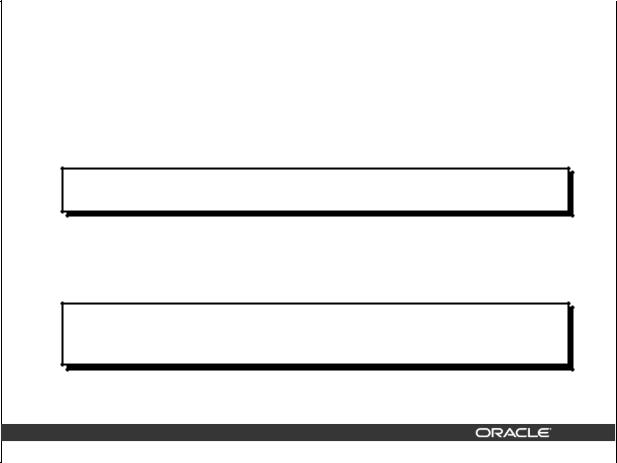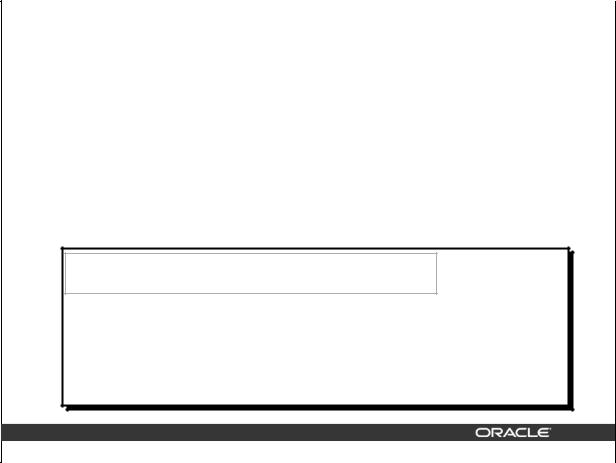
Semestr2 / 1 - Oracle / Student_9-14
.pdf
Creating an Index
•Create an index on one or more columns.
CREATE INDEX index
ON table (column[, column]...);
•Improve the speed of query access to the
LAST_NAME column in the EMPLOYEES table.
CREATE INDEX emp_last_name_idx
ON employees(last_name);
Index created.
12-17 |
Copyright © Oracle Corporation, 2001. All rights reserved. |
Creating an Index
Create an index on one or more columns by issuing the CREATE INDEX statement. In the syntax:
index |
is the name of the index |
table |
is the name of the table |
column |
is the name of the column in the table to be indexed |
For more information, see Oracle9i SQL Reference, “CREATE INDEX.”
Introduction to Oracle9i: SQL Basics 12-17

When to Create an Index
You should create an index if:
•A column contains a wide range of values
•A column contains a large number of null values
•One or more columns are frequently used together in a WHERE clause or a join condition
•The table is large and most queries are expected to retrieve less than 2 to 4 percent of the rows
12-18 |
Copyright © Oracle Corporation, 2001. All rights reserved. |
More Is Not Always Better
More indexes on a table does not mean faster queries. Each DML operation that is committed on a table with indexes means that the indexes must be updated. The more indexes you have associated with a table, the more effort the Oracle server must make to update all the indexes after a DML operation.
When to Create an Index
Therefore, you should create indexes only if:
•The column contains a wide range of values
•The column contains a large number of null values
•One or more columns are frequently used together in a WHERE clause or join condition
•The table is large and most queries are expected to retrieve less than 2–4% of the rows
Remember that if you want to enforce uniqueness, you should define a unique constraint in the table definition. Then a unique index is created automatically.
Introduction to Oracle9i: SQL Basics 12-18

When Not to Create an Index
It is usually not worth creating an index if:
•The table is small
•The columns are not often used as a condition in the query
•Most queries are expected to retrieve more than 2 to 4 percent of the rows in the table
•The table is updated frequently
•The indexed columns are referenced as part of an expression
12-19 |
Copyright © Oracle Corporation, 2001. All rights reserved. |
Introduction to Oracle9i: SQL Basics 12-19

Confirming Indexes
•The USER_INDEXES data dictionary view contains the name of the index and its uniqueness.
•The USER_IND_COLUMNS view contains the index name, the table name, and the column name.
|
SELECT |
ic.index_name, ic.column_name, |
|
|
|
|
|||
|
|
ic.column_position col_pos,ix.uniqueness |
|
|
|
FROM |
user_indexes ix, user_ind_columns ic |
|
|
|
WHERE |
ic.index_name = ix.index_name |
|
|
|
AND |
ic.table_name = ’EMPLOYEES’; |
|
|
|
|
|
|
|
|
|
|
|
|
12-20 |
Copyright © Oracle Corporation, 2001. All rights reserved. |
Confirming Indexes
Confirm the existence of indexes from the USER_INDEXES data dictionary view. You can also check the columns involved in an index by querying the USER_IND_COLUMNS view.
The example on the slide displays all the previously created indexes, with the names of the affected column, and the index’s uniqueness, on the EMPLOYEES table.
Introduction to Oracle9i: SQL Basics 12-20

Function-Based Indexes
•A function-based index is an index based on expressions.
•The index expression is built from table columns, constants, SQL functions, and user-defined functions.
CREATE INDEX upper_dept_name_idx
ON departments(UPPER(department_name));
Index created.
SELECT *
FROM departments
WHERE UPPER(department_name) = ’SALES’;
12-21 |
Copyright © Oracle Corporation, 2001. All rights reserved. |
Function-Based Index
Function-based indexes defined with the UPPER(column_name) or LOWER(column_name) keywords allow case-insensitive searches. For example, the following index:
CREATE INDEX upper_last_name_idx ON employees (UPPER(last_name));
Facilitates processing queries such as:
SELECT * FROM employees WHERE UPPER(last_name) = ’KING’;
To ensure that the Oracle server uses the index rather than performing a full table scan, be sure that the value of the function is not null in subsequent queries. For example, the following statement is guaranteed to use the index, but without the WHERE clause the Oracle server may perform a full table scan:
SELECT *
FROM |
employees |
WHERE |
UPPER (last_name) IS NOT NULL |
ORDER BY UPPER (last_name);
Introduction to Oracle9i: SQL Basics 12-21
Function-Based Index (continued)
The Oracle server treats indexes with columns marked DESC as function-based indexes. The columns marked DESC are sorted in descending order.
Introduction to Oracle9i: SQL Basics 12-22

Removing an Index
•Remove an index from the data dictionary by using the DROP INDEX command.
DROP INDEX index;
•Remove the UPPER_LAST_NAME_IDX index from the data dictionary.
DROP INDEX upper_last_name_idx;
Index dropped.
•To drop an index, you must be the owner of the index or have the DROP ANY INDEX privilege.
12-23 |
Copyright © Oracle Corporation, 2001. All rights reserved. |
Removing an Index
You cannot modify indexes. To change an index, you must drop it and then re-create it. Remove an index definition from the data dictionary by issuing the DROP INDEX statement. To drop an index, you must be the owner of the index or have the DROP ANY INDEX privilege.
In the syntax:
index is the name of the index
Note: If you drop a table, indexes and constraints are automatically dropped, but views and sequences remain.
Introduction to Oracle9i: SQL Basics 12-23

Synonyms
Simplify access to objects by creating a synonym (another name for an object). With synonyms, you can:
•
•
Ease referring to a table owned by another user
Shorten lengthy object names
CREATE [PUBLIC] SYNONYM synonym
FOR object;
12-24 |
Copyright © Oracle Corporation, 2001. All rights reserved. |
Creating a Synonym for an Object
To refer to a table owned by another user, you need to prefix the table name with the name of the user who created it followed by a period. Creating a synonym eliminates the need to qualify the object name with the schema and provides you with an alternative name for a table, view, sequence, procedure, or other objects. This method can be especially useful with lengthy object names, such as views.
In the syntax: |
|
PUBLIC |
creates a synonym accessible to all users |
synonym |
is the name of the synonym to be created |
object |
identifies the object for which the synonym is created |
Guidelines
•The object cannot be contained in a package.
•A private synonym name must be distinct from all other objects owned by the same user. For more information, see Oracle9i SQL Reference, “CREATE SYNONYM.”
Introduction to Oracle9i: SQL Basics 12-24

Creating and Removing Synonyms
•Create a shortened name for the
DEPT_SUM_VU view.
CREATE SYNONYM d_sum
FOR dept_sum_vu;
Synonym Created.
•Drop a synonym.
DROP SYNONYM d_sum;
Synonym dropped.
12-25 |
Copyright © Oracle Corporation, 2001. All rights reserved. |
Creating a Synonym for an Object (continued)
The slide example creates a synonym for the DEPT_SUM_VU view for quicker reference.
The database administrator can create a public synonym accessible to all users. The following example creates a public synonym named DEPT for Alice’s DEPARTMENTS table:
CREATE PUBLIC SYNONYM dept
FOR alice.departments;
Synonym created.
Removing a Synonym
To drop a synonym, use the DROP SYNONYM statement. Only the database administrator can drop a public synonym.
DROP PUBLIC SYNONYM dept;
Synonym dropped.
For more information, see Oracle9i SQL Reference, “DROP SYNONYM.”
Introduction to Oracle9i: SQL Basics 12-25

Summary
In this lesson, you should have learned how to:
•Automatically generate sequence numbers by using a sequence generator
•View sequence information in the USER_SEQUENCES data dictionary table
•
•
•
Create indexes to improve query retrieval speed
View index information in the USER_INDEXES dictionary table
Use synonyms to provide alternative names for objects
12-26 |
Copyright © Oracle Corporation, 2001. All rights reserved. |
Summary
In this lesson you should have learned about some of the other database objects including sequences, indexes, and views.
Sequences
The sequence generator can be used to automatically generate sequence numbers for rows in tables. This can save time and can reduce the amount of application code needed.
A sequence is a database object that can be shared with other users. Information about the sequence can be found in the USER_SEQUENCES table of the data dictionary.
To use a sequence, reference it with either the NEXTVAL or the CURRVAL pseudocolumns.
•Retrieve the next number in the sequence by referencing sequence.NEXTVAL.
•Return the current available number by referencing sequence.CURRVAL.
Indexes
Indexes are used to improve query retrieval speed. Users can view the definitions of the indexes in the USER_INDEXES data dictionary view. An index can be dropped by the creator, or a user with the DROP ANY INDEX privilege, by using the DROP INDEX statement.
Synonyms
Database administrators can create public synonyms and users can create private synonyms for convenience, by using the CREATE SYNONYM statement. Synonyms permit short names or alternative names for objects. Remove synonyms by using the DROP SYNONYM statement.
Introduction to Oracle9i: SQL Basics 12-26
